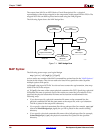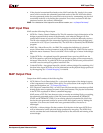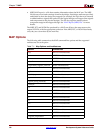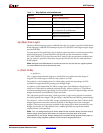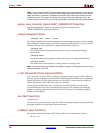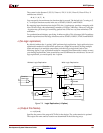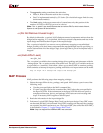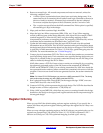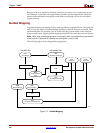
138 www.xilinx.com Development System Reference Guide
Chapter 7: MAP
R
• If you do not specify an output file name with the –o option, the output file has the
same name as the input file, with a .ncd extension. The file is placed in the input file’s
directory
• If you specify an output file name with no path specifier (for example, cpu_dec.ncd
instead of /home/designs/cpu_dec.ncd), the NCD file is placed in the current working
directory.
• If you specify an output file name with a full path specifier (for example,
/home/designs/cpu_dec.ncd), the output file is placed in the specified directory.
If the output file already exists, it is overwritten with the new NCD file. You do not receive
a warning when the file is overwritten.
Note:
However, signals connected to pads or to the outputs of BUFTs, flip-flops, latches, and
RAMS are preserved for back-annotation.
–ol (Overall Effort Level)
–ol [std|med|high]
The –ol option is available when running timing-driven packing and placement with the –
timing option. The –ol option sets the overall MAP effort level. The effort level specifies the
level of effort MAP uses to pack the design.
Of the three effort_level values, use std for low effort level (fastest runtime at expense of
QOR), use med for medium effort level (balance of runtime and QOR), use high for high
effort level (best QOR with increased runtime).
The default effort level in MAP is high. Following is command line syntax for using the
–
ol option, set to std:
map –timing –ol std design.ncd output.ncd design.pcf
Note: The –ol option is ignored if the –timing option is not set.
–p (Part Number)
–p part
Specifies the Xilinx part number for the device. The syntax for the –p option is described in
“–p (Part Number)” in Chapter 1.
If you do not specify a part number using the –p option, MAP selects the part specified in
the input NGD file. If the information in the input NGD file does not specify a complete
device and package, you must enter a device and package specification using the –p
option. MAP supplies a default speed value, if necessary.
The architecture you specify with the –p option must match the architecture specified
within the input NGD file. You may have chosen this architecture when you ran
NGDBuild or during an earlier step in the design entry process (for example, you may
have specified the architecture as an attribute within a schematic, or specified it as an
option to a netlist reader). If the architecture does not match, you have to run NGDBuild
again and specify the desired architecture.
You can only enter a part number or device name from a device library you have installed
on your system. For example, if you have not installed the 4006E device library, you cannot
create a design using the 4006E–PC84 part.



